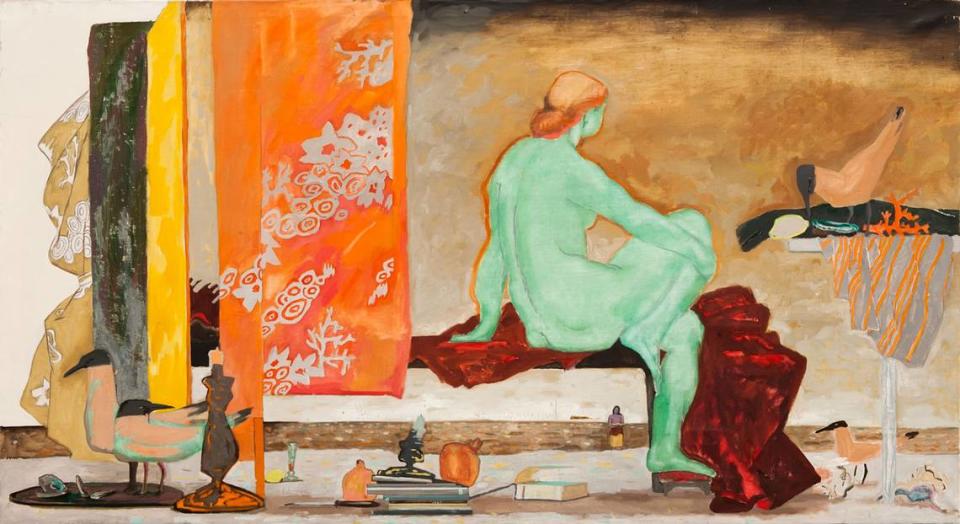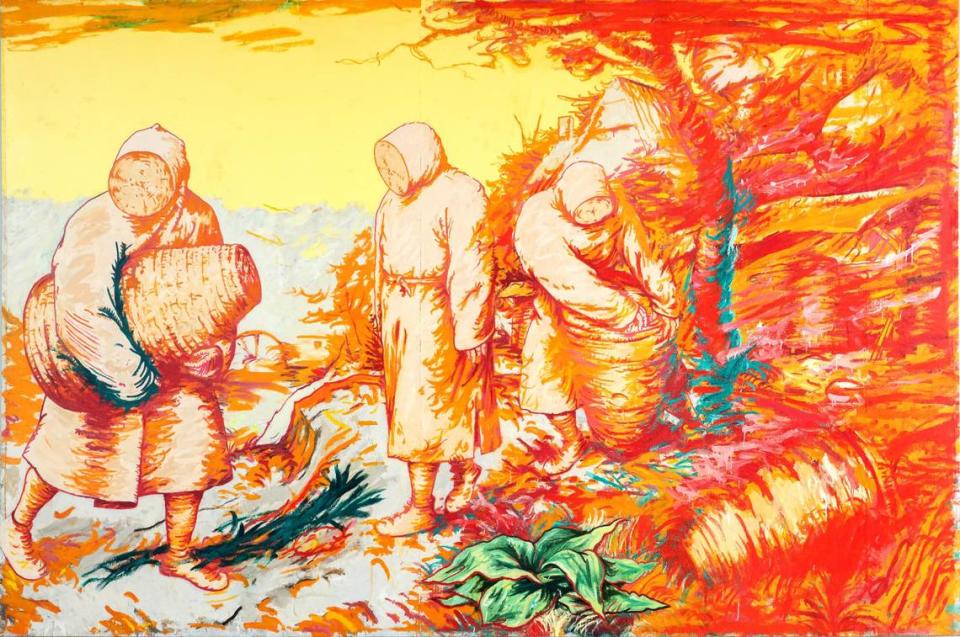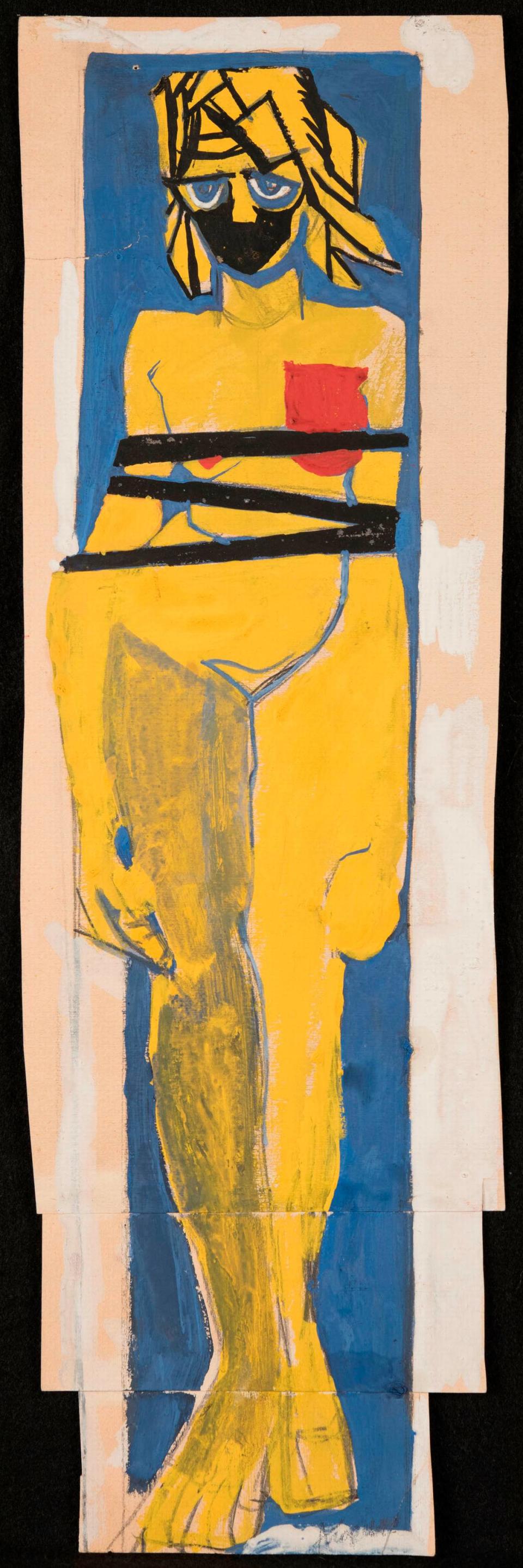‘Symbols of change.’ Ukrainian exhibit at Coral Gables Museum celebrates rebellious artists
A nude green goddess relaxes on pile of burgundy fabric as she stares into the distance. Her back is turned to the viewer, her fiery red hair tied into a sensible bun. Birds stand by her collection of books and pottery strewn on the floor.
It’s a calm scene that was painted during a tumultuous time. Yana Bystrova, the artist, painted the goddess in Kyiv, the capital of Ukraine in 1989 at just 23 years old. The Soviet Union was a few years away from collapse, which meant that the strict censorship of artists would soon be obsolete. Bystrova’s world would suddenly become a much more colorful place.
Today, the goddess once again overlooks a calm scene during a tumultuous time. Bystrova is in Paris, devastated as she watches her home country at war Russia. Her painting, called “The Deity of Chill During Her Crimean Stay,” is on display at the Coral Gables Museum for “Painting in Excess: Kyiv’s Art Revival, 1985-1993,” an exhibition on Ukrainian avant-garde works made just before and after the fall of the Soviet Union.

“The pieces are symbols of change,” said Yuneikys Villalonga, the Coral Gables Museum chief curator. “[The artists] were really doing things that were not allowed before.”
The Coral Gables show, on view until October 30, is the latest effort by Miami art institutions to embrace Ukrainian art and culture since the war began. Proceeds from ticket sales will be donated to Razom for Ukraine, a relief organization.
The exhibition arrived at the Coral Gables Museum in May, though that wasn’t always the plan. “Painting in Excess” was originally curated for and displayed in the Zimmerli Art Museum at Rutgers University in New Jersey late last year, months before Russia invaded.
Though most of the artworks are from the Zimmerli’s massive collection of Soviet non-conformist art, about 30 percent of the works were loaned from Ukraine. Those paintings couldn’t be returned home, so the Zimmerli decided to tour the exhibition. Coral Gables is the first stop.
Villalonga said the exhibition is an opportunity for the local community to not just donate to charity but to also learn more about Ukrainian history and culture through art.
“This is something that could get to the hearts of all Miamians,” she said.
“It’s very liberating”
The show features 35 artists and 64 paintings, including larger-than-life paintings like “Sacred Landscape of Pieter Bruegel” by Georgii Senchenko, situated to the left of the gallery’s entrance. Its impressive size and saturated colors immediately immerse the viewer.
On the wall next to Senchenko’s work is a much smaller painting called “(Silence)“ by Alla Horska. It’s a yellow nude woman in front of a blue background, the Ukrainian flag colors. A black mask covers her mouth and black rope binds her arms.

Many of the works on display are excessively colorful, others are deeply critical of the communist regime. All rebelled against socialist realism, the Soviet Union’s official style of propaganda art, and drew inspiration from Western art styles, said Julia Tulovsky, an associate curator at Rutgers.
Tulovsky, who is Russian, worked closely with Olena Martynyuk, the Ukrainian guest curator who organized the exhibition. The show, which showcases Ukraine’s national artistic identity, is incredibly relevant to the crisis in today, Tulovsky said.
In the late 80s, Ukrainian artists worked in secretive groups to evade censorship, Tulovsky explained. The regime forbade abstract art, and nude Renaissance paintings were considered pornography.
It was risky for young artists to challenge the Soviet Union’s status quo, but the underground art movement flourished. Painters indulged in huge canvases, rich colors, abstract styles, geometric designs and Western ideals.

“It’s very liberating in a way. This Baroque excess, which this exhibition presents, is really cool,” Tulovsky said. “It’s beautiful.”
Bystrova remembers that time well. Born into a family of artists, she grew up in Kyiv, where virtually no information from the outside world was let in. But as the Soviet Union neared collapse, the future was uncertain.
Young artists like herself dabbled in nonconformist works. While studying at an art academy, she and her classmates were almost kicked out because their work wasn’t “classical enough.”
“No one knew whether you would be sent off to Gulag or maybe you will be a new prophet,” she said. “Lots of things were shifting. People were hopeful that there was promise of a better, more open future.”
Shortly after the Soviet Union fell, Bystrova moved to Paris, where she has lived for the last 30 years. She was supposed to return to Kyiv in March for a family art exhibition of her, her mother and her grandfather’s work. Instead, her mother fled to Paris.
“Some artists manage to keep working. I, unfortunately, was in the middle of some project and I stopped,” she said. “I’m devastated. Time stops existing.”
Despite the hardships, Bystrova said she is happy to know that American audiences have taken an interest in Ukrainian contemporary art after decades of Russian propaganda. “Painting in Excess” is a silver lining, she said.
“Ukraine has been in the shadow for a long time,” she said. Not anymore.
Painting in Excess: Kyiv’s Art Revival, 1985-1993
Where: Coral Gables Museum. 285 Aragon Ave, Coral Gables
When: On view until October 30
Price: $12 for adults. $8 for students and seniors. $5 for children. Free for children under age 7.
Info: https://coralgablesmuseum.org/portfolio-item/painting-in-excess/
This story was produced with financial support from The Pérez Family Foundation, in partnership with Journalism Funding Partners, as part of an independent journalism fellowship program. The Miami Herald maintains full editorial control of this work.

